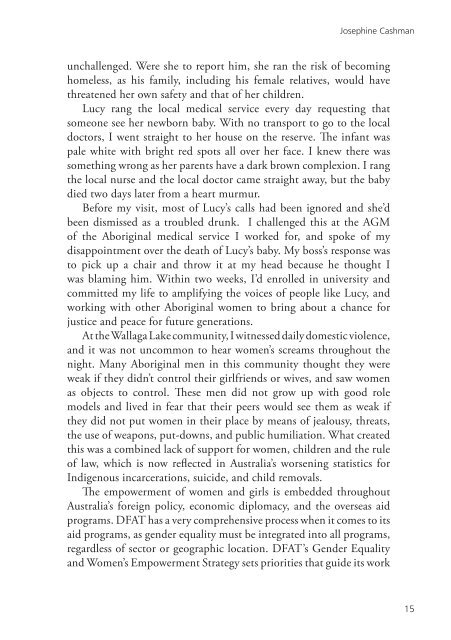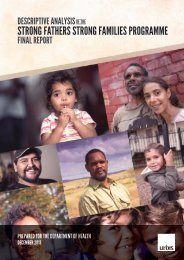Ending the Violence in Indigenous Communities
op152
op152
Create successful ePaper yourself
Turn your PDF publications into a flip-book with our unique Google optimized e-Paper software.
Joseph<strong>in</strong>e Cashman<br />
unchallenged. Were she to report him, she ran <strong>the</strong> risk of becom<strong>in</strong>g<br />
homeless, as his family, <strong>in</strong>clud<strong>in</strong>g his female relatives, would have<br />
threatened her own safety and that of her children.<br />
Lucy rang <strong>the</strong> local medical service every day request<strong>in</strong>g that<br />
someone see her newborn baby. With no transport to go to <strong>the</strong> local<br />
doctors, I went straight to her house on <strong>the</strong> reserve. The <strong>in</strong>fant was<br />
pale white with bright red spots all over her face. I knew <strong>the</strong>re was<br />
someth<strong>in</strong>g wrong as her parents have a dark brown complexion. I rang<br />
<strong>the</strong> local nurse and <strong>the</strong> local doctor came straight away, but <strong>the</strong> baby<br />
died two days later from a heart murmur.<br />
Before my visit, most of Lucy’s calls had been ignored and she’d<br />
been dismissed as a troubled drunk. I challenged this at <strong>the</strong> AGM<br />
of <strong>the</strong> Aborig<strong>in</strong>al medical service I worked for, and spoke of my<br />
disappo<strong>in</strong>tment over <strong>the</strong> death of Lucy’s baby. My boss’s response was<br />
to pick up a chair and throw it at my head because he thought I<br />
was blam<strong>in</strong>g him. With<strong>in</strong> two weeks, I’d enrolled <strong>in</strong> university and<br />
committed my life to amplify<strong>in</strong>g <strong>the</strong> voices of people like Lucy, and<br />
work<strong>in</strong>g with o<strong>the</strong>r Aborig<strong>in</strong>al women to br<strong>in</strong>g about a chance for<br />
justice and peace for future generations.<br />
At <strong>the</strong> Wallaga Lake community, I witnessed daily domestic violence,<br />
and it was not uncommon to hear women’s screams throughout <strong>the</strong><br />
night. Many Aborig<strong>in</strong>al men <strong>in</strong> this community thought <strong>the</strong>y were<br />
weak if <strong>the</strong>y didn’t control <strong>the</strong>ir girlfriends or wives, and saw women<br />
as objects to control. These men did not grow up with good role<br />
models and lived <strong>in</strong> fear that <strong>the</strong>ir peers would see <strong>the</strong>m as weak if<br />
<strong>the</strong>y did not put women <strong>in</strong> <strong>the</strong>ir place by means of jealousy, threats,<br />
<strong>the</strong> use of weapons, put-downs, and public humiliation. What created<br />
this was a comb<strong>in</strong>ed lack of support for women, children and <strong>the</strong> rule<br />
of law, which is now reflected <strong>in</strong> Australia’s worsen<strong>in</strong>g statistics for<br />
<strong>Indigenous</strong> <strong>in</strong>carcerations, suicide, and child removals.<br />
The empowerment of women and girls is embedded throughout<br />
Australia’s foreign policy, economic diplomacy, and <strong>the</strong> overseas aid<br />
programs. DFAT has a very comprehensive process when it comes to its<br />
aid programs, as gender equality must be <strong>in</strong>tegrated <strong>in</strong>to all programs,<br />
regardless of sector or geographic location. DFAT’s Gender Equality<br />
and Women’s Empowerment Strategy sets priorities that guide its work<br />
15



